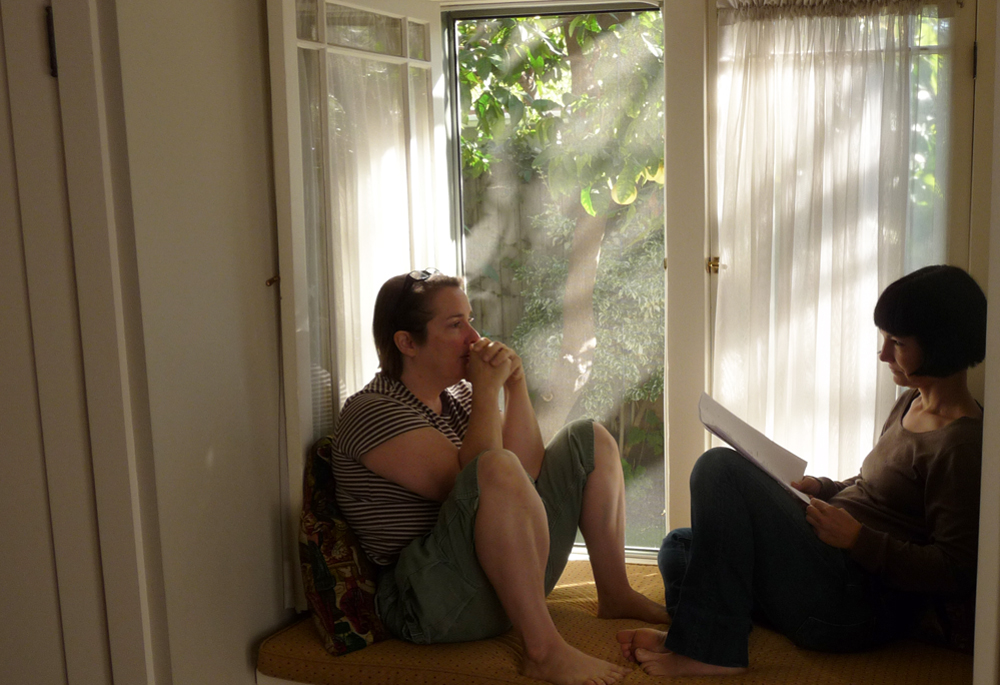Jillian Armenante and Alice Dodd
For Jillian Armenante and Alice Dodd their 1923 Mediterranean home in Hollywood is a perfect place for their full lives. Armenante, easily recognized for her role as Donna Kozlowski on Judging Amy, and wife Dodd also co-produced, co-directed and co-wrote Laura Comstock's Bag-Punching Dog which won the Theatre L.A. Ovation Award for "Best New Musical" and "Best Musical Production". In this interview they share their home; their creativity is focused by the nuances and particulars of the unique space which allows them to work together successfully.
•
Back in 2000, almost by accident, we bought a 1923 Mediterranean in the middle of Hollywood. We happened by an open house, instantly fell in love with it and without ever looking at another house, offered to buy it. Maybe it was the grapefruit tree, or the easy walk to the Larchmont Farmers Market, or the legacy of the Hollywood sign looming in the distance-we just had to have it. We knew it would be the perfect place to start building a family. Well, almost perfect, after we made a few additions here and there. We now have two beautiful girls ages 2 and 6 to mess it all up.
We are both actors, but work as a team on our numerous writing projects. Being able to work out of one’s house is both a blessing and a curse. It is a blessing in that you can write or memorize dialogue for hours without ever having to find your pants. However, when one needs to concentrate with two kids running around, it can be a bit of a curse. It is difficult for us to think in clutter...chaos. Our home is decorated in 18th and 19th century furnishings and the juxtaposition of the inevitable brightly-colored plastic toys can be a bit maddening. We do our best work when we can find that one area of the house that has been untainted by the detritus of the kids’ day.
For instance, the only official “office” space is a small detached room in the corner of the backyard. We don’t want to say “converted garage” because, like a lot of structures behind Hollywood homes, the transition from garage to office was not a city-permitted venture. It’s where we house our library and is where we tend to do most of our research and organized thinking.
The antique partners desk enables us to face each other as we bounce ideas back and forth, the baby monitor hissing gently in the background. The oversized windows and a glass door allow us to see the backyard in it’s entirety, as the girls play on the swing, in the sandbox or up the apricot tree.
But the real heart of the house is the kitchen. As actors, we work together to memorize lines in preparation for an audition or a shoot. These rehearsals most often end up at the kitchen table in spare moments snatched from the day’s schedule.
The deep red tones, regency chairs, the giant rooster staring down at us are lit by the ever-present California sun. And at nightfall, the kitchen is where the post-dinner dance happens, usually to a Rosemary Clooney song or the likes, as the family, en masse, blows off a little steam. After the girls are asleep, the kitchen table is where the brainstorming begins. A legal pad... a bottle of wine... invariably leads to the evening’s furious scribble-fest.
To generate new material we often link up two keyboards and connect them to the television in the living room so both of us can have control over the same document.
At night the uncluttered space, low light and more formal setting makes it a place free from the physical and psychological happenings of the day. It’s the room where we can light a fire, swirl a medium-bodied red and dig in.
When reading through and evaluating drafts, we often treat ourselves to an outdoor session: sitting on Adirondack chairs, we project the computer onto a ten-foot screen and sit under the stars ruminating our literary efforts. When school projects and various arts and crafts have consumed our surfaces, we resort to alternative venues: our bedroom window-seat, the front porch, or even the bathroom, with one of us in the tub as the other quizzes from the throne of the toilet seat.
This is how we imagine the first inhabitants of this house, the actors and actresses of the 1920’s, working on their lines. Houses are like handbags. We will always manage to fill the space we have to maximum capacity. If we only had more storage...

